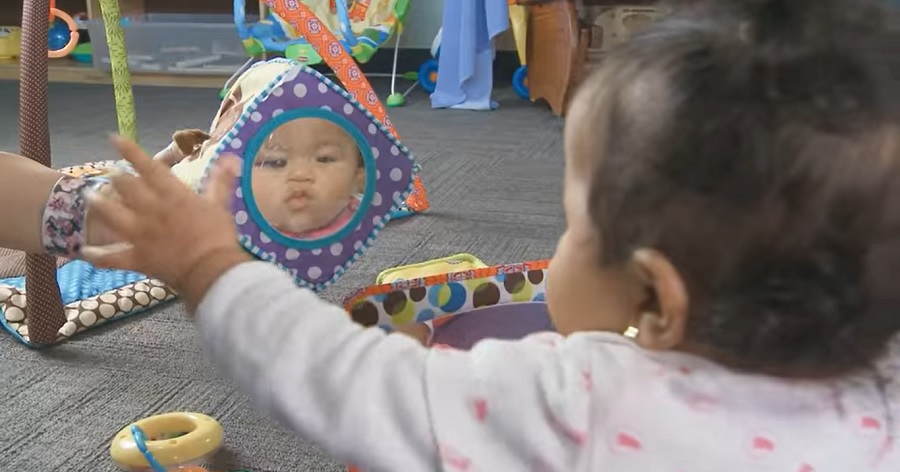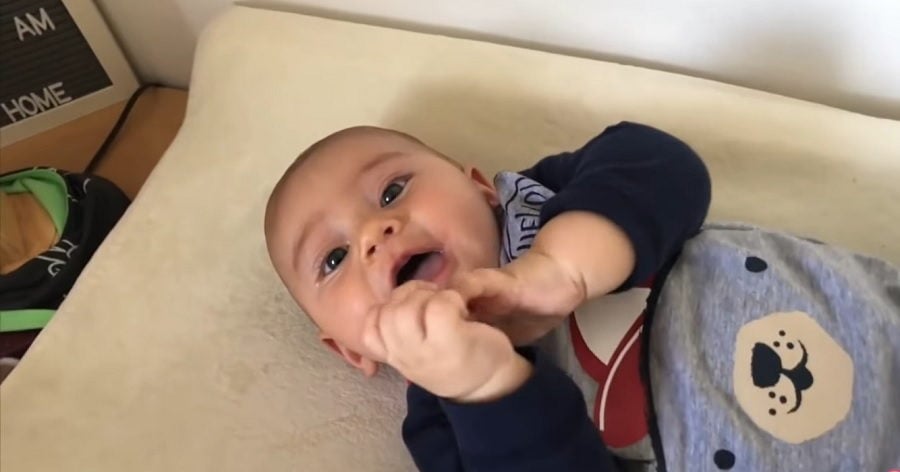
The arrival of a new member in the family brings a lot of excitement and joy. However, happiness and delight aren't the only accompaniments, for, with the baby comes responsibilities and duties. Responsibility to pay heed to all its needs and give it a good life and to make sure that the responsibility is carried out well. Furthermore, what comes with a baby is sleep deprivation for parents. Such is the state that dark circles and sacks under the eyes is a common sight seen in new parents, especially mothers. If you too are facing a similar problem and are looking for ways to make your tiny tot fall asleep so that you too can catch up with your sleep, understand that all this mayhem will continue till you are successfully able to sleep train your baby. Babies need a lot of time to adapt themselves according to the sleep schedule of the parents, but there are a number of sleep training programs which are readily available and are effective. Wondering why the delay then? Well, the only hitch is that you can never readily know which kind of training you should impart to your baby. A trial and error method, you have to try a number of approaches before getting to the right one. There are a number of reasons why a baby wakes up at odd hours in the night, like if a baby is hungry, if it is not well, if it has overslept during the day and so on. Also, at times the baby starts relating sleep time with certain things like feed, or even material things like a pacifier. An approach states that feeding while bedtime or just before bedtime makes the baby relate feeding to sleep and hence, every time it wakes up while sleeping, it has to be fed to be pacified. There are a number of sleep training methods and sleep positions which are popular because of their effectiveness. So mommies and daddies keep scrolling to know that different sleep training methods and sleep positions that will help you make a sleep schedule for you little one, in turn giving you your much needed “Me Time.”

Image Credit: https://www.youtube.com/watch?v=FM918Rpgjgo
Infant Sleep Training
The biggest fear when a baby is born might be the sleepless nights that follow and as for a newborn, it is difficult to differentiate between days and nights. Due to this, it keeps on waking up a number of times during day and night, leaving the parents baffled. The newborn needs time to adjust to the sleep schedule that his parents follow. But if the baby has been continuing with the same even after six months, there is something definitely wrong. After the third month, babies are ready to be sleep trained and are capable of sleeping through the night. For the same, there are a number of methods available, which are devised by expert paediatricians. Sleep training a baby is a trial and error process. And as each pregnancy is different and so is every child. What worked for your first baby may not work for the second baby. Some instinct and experience will help you to decide the kind of training you need to impart to your bundle of joy.
What is the meaning of sleep training?
Putting it in simple words – sleep training is teaching your bundle of joy to sleep without your (parents or caregiver’s) assistance. Sleep training helps your baby to self-soothe without being cuddled, rocked, nursed or swayed and how to fall back to sleep when he wakes up inevitably. The primary aim of sleep training is that your tiny tot sleeps through the night comfortably on its own.
When should you start sleep training?
Going by the recommendation of Dr. Schwartz, sleep training should begin when your infant is about four months old. Around same time your baby’s circadian rhythm – the hormone cycle that regulates the sleep-wake cycles starts to work. By this age the babies may no longer require night feedings and are old enough to learn to soothe themselves on their own. However, as every child is different, few may do better a little earlier and some may require more time. Commonly, it takes a baby 12-16 weeks from birth to adapt a regular sleep pattern.
How long does sleep training take?
This question is a bit tricky. Why? Because the amount of time required training your tiny tot depends on the sleep training method that you choose. Usually it might it four to five nights, but for some it might take longer. Largely depends on the parents plan and how consistent they are in putting it to practise.
Which sleep training method should I choose for my baby?
With so many options and approaches to sleep train a baby, it becomes confusing for the parents to choose a particular approach. You should choose the approach which is easier for you to follow so that you can follow it consistently, because it is not the approach which is important but how consistently you follow the regimen and how well the baby responds to it.
Baby Sleep Training Methods (Sleep Training Techniques)
Personal Method
It might be a little surprising for you to know that the method with which you try to make your baby sleep may be the best method for your teeny weeny, as it is a personalized way which is designed by you keeping in consideration the comfort and needs of the baby. You might get overwhelmed with the infant crying and may get apprehensive about the method you are using to pacify it, but if you go according to your instincts, then it might turn out to be the best suited method for your baby.
Pick-up and Put-Down Or Baby Whisper Method
The approach is set around cry it out and no cry methods. Also known as baby whisper, this approach is all about working out a way to understand the baby and its needs. The parents are supposed to listen and observe baby's behaviour so they can easily catch the behavioural signals and symbols which a baby projects while asleep as well as when it's awake. While teaching a baby to sleep alone, the method promotes that instead of holding, nursing or rocking the baby, parents should comfort the baby by picking it up, and putting down as often as needed until it sleeps.
This is one of the most popular methods adopted by parents to make their child sleep. The method advocates a humane approach to make a baby fall asleep. The approach is simple. Just pick the baby whenever she cries, soothe her, feed her if needed, put her back in their crib or bed, drowsy but awake. Repeat it every time the little one wakes up and cries. This approach aims at teaching your bundle of joy that you are near her and that she is safe and she can fall asleep on her own as you are around.
Attachment Parenting
This is an approach which is centred on nurturing the baby and this approach advocates gently guiding the baby to sleep on its own pace. Crying out is not a part of attachment parenting, but it includes keeping the baby active during the period it stays awake so that it wears out before going to sleep. Breastfeeding the baby and co-sleeping with the baby is also suggested in the approach. This way, the baby takes its own time to get accustomed to the sleep routine of the parents.
Cry it Out (CIO Method)
Crying it out is one of the oldest and the most common methods of sleep training. According to this method, the baby should learn to comfort itself on its own. During this method, the baby is left crying for a particular period before it is comforted by the parents but even during comforting the baby isn't picked up or fed. Though this is an emotionally taxing method for both the parents and the infant, through this method, an infant learns to sleep on its own, without the help of parents or caregivers.
Chair Method
In this approach the parents or caregivers do not use soothing techniques to calm a fussy or crying baby. They simply place their chair near the crib or bed of the baby and sit beside the tiny tot until it falls asleep. With each passing night, the chair is moved slightly away from the crib. For example – initially the parents place the chair right next to the crib and hold the baby’s hand while it falls asleep. Gradually the chair is moved away from the crib and by the end of the training the baby is able to sleep with the caregiver or parent’s presence in her room.
Ferber Method
Also known as the check-and-console method, this allows your baby to cry for sometime before you reach out to soothe you tiny tot. You need to attend to your baby’s cries at set intervals and gradually increase the time each night. By the end of this training method you teeny weeny learns to self-soothe and fall asleep on its own without your comfort check-ins.
No Tears
This approach suggests that routine plays an important role in a baby’s sleep training. Parents should follow a set routine wherein a baby is bathed, fresh clothes are put on, a lullaby is sung and the baby is put to sleep. This, when followed on daily basis, will induce the baby to make it the part of the routine. As such, the moment it would be taken for a bath it would know what would be followed next and as such would fall asleep instantly.
Though through this approach a baby learns a healthy sleep attitude and creates fond memories about being parented to sleep, it relies on the outside prop to get to sleep.
Newborn Sleep Schedule
Wondering whether your baby will ever sleep through the night? Are you exhausted and frustrated trying to put your baby to sleep? Trying to discover what will make your baby have peaceful and sound sleep? Well, you are not alone who’s feeling this way. You are amongst the millions of parents who face difficulties in making their babies fall asleep. Relax and take a deep breath. This won’t last forever, but yes, till it does, it is obvious to feel anxious and we know you are sleep deprived. To deal with this, it is important to put your baby on a proper sleeping schedule from birth. By inculcating the habit of a regular and timely sleeping schedule from birth, you can ensure yourself and your baby a comfortable and peaceful night sleep.
What are the sleep patterns of a newborn?
It is often difficult, especially for new parents to determine the sleep patterns of a newborn. However, the fact is that there is no set schedule initially because majority of newborns have their days and nights confused. Newborns usually sleep 15-16 hours a day. But it’s not as easy as it seems. This sleep pattern comes in short intervals as the baby wakes up frequently for feeding and popping.
When can I put my baby on a sleep schedule?
Usually by the time a baby turns 2 months old, its internal clock becomes a bit more predictable, that’s when you may try putting your little when on a sleep schedule.
Tips For Getting Your Baby On A Sleep Schedule
Create a Routine
If you start with a fixed schedule and routine, it is sure to help your newborn and it will also develop into a healthy habit that will stay with your child forever. Hence, it is significant to establish a sleeping pattern for your baby. You can begin off with giving your baby a warm bath, change clothes, and read a good book. These activities will help in signalling your baby that it is time for bed and a good sleep.
Set Timings
If you set a routine, it is important to set timings and more importantly, stick to it. Eventually, with time, your baby will become accustomed to the time you take it to bed and fall asleep easily and quickly. Give it a try for few days continuously and you are sure to notice the change soon.
Build a Comfy Ambiance
Agreed that babies are unable to fall asleep in extremely noisy and ear-splitting environment, but that does not mean they demand pin-drop silence. A too-quiet room can, in fact, make it difficult for a baby to fall asleep. You can put on some white noise machine, like a fan, running on low speed. Make sure that the temperature of the room is neither too cold nor too hot. Dress up your baby comfortably and put it to sleep in a comfortable temperature.
Set Up A Night Lamp
A baby night light will be highly useful, particularly in the first few months after childbirth. You will require it while changing your baby’s clothes or feeding it. However, always keep the light low and avoid talking or interacting with your baby if it breaks from its sleep in the middle of the night. Doing so will keep it awake and find interest in the conversation. Hence, avoid any kind of conversation to indicate it that it’s still night time.
Study Your Baby’s Signals
Unless you are aware of your baby’s cues, you will not be able to help your tiny tot in establishing a proper sleeping pattern. Over a period of time, when your baby has developed the habit of falling asleep on time, it will signal you when it is tired and wants to be swaddled to sleep. For this as well, you will have to develop a habit in yourself to help it with the schedule. Therefore, notice and be attentive to its behaviour.
Pacify Your Baby
Whenever you get the slightest indication that your baby is willing to sleep, you can soothe it, contributing to its sleep. Swaddle it into your arms while rocking or walking around the room. You can also opt to read or sing softly. When your baby gets drowsy, lay it in the crib. Alternatively, you can lay it in the crib while it is still awake, which will help it sleep on its own.
Be Flexible
As each baby is different, some get accustomed to a fixed routine and love following it, while others like to go-with-the-flow. It is important to implement routines, however, adjusting them to the natural rhythms of your little one helps in sticking to them easily.
Baby Sleep Positions
Newborn babies spent most of their time sleeping, which is important for their overall health and growth process. Besides, while the babies are off to sleep, the mothers, too, can take a huge sigh of relief and enjoy some time in peace and relaxation. Nevertheless, what is most important while your little one is dozing off is to ensure that it is safe while sleeping. Sounds weird and out of place, right? How can a baby not be safe while sleeping? Well, the piece that’s missing here to fit into the puzzle is that while a baby is sleeping, its sleeping position is of utmost importance. For, if it is not lying in the correct position, your baby is at the risk of suffering from Sudden Infant Death Syndrome (SIDS). Although very few babies die from SIDS, it is a matter of concern for all new parents. You cannot compromise with the sleeping position or sleeping place of your baby, since it is fragile and sensitive. For this reason, it is extremely crucial to put your baby to sleep in the right position, to prevent any kind of health risks. By practicing some simple guidelines, you can lay your baby down to sleep in the most comfortable and safe position.
Baby Sleeping Positions
Back Sleeping
Do you easily fall asleep on your back? Not, really. For, it is not a comfortable sleeping position for most people. Not for most babies, either. However, to protect your baby from the risk of SIDS, you need to teach your baby to fall asleep on its back. Also, this position reduces the chances of your baby choking.
Tummy Sleeping
Putting your baby to sleep on tummy has the highest risk of SIDS for babies. Although you may have put baby to sleep on back sleeping position, it is likely to turn its face to the side while sleeping, resulting in getting its nose pressed to the mattress, thereby leading to suffocation. Besides, your baby is also at the risk of inhaling harmful germs present in the so-called clean mattress. You can let your baby lie on its stomach when it’s awake, though you should keep a constant eye on it. Parents are recommended to put their baby to sleep on its tummy, only if the little one is suffering from respiratory problems, upper airway malfunctions, and if it spits a lot. Though this sleep position can strengthen the neck and shoulder muscles of your baby, it is a big ‘NO’ as a general sleeping position.
Side Sleeping
Even though side sleeping is considered a safer position than prone sleeping, it has a higher risk of SIDS than back sleeping, since the baby can roll over to its tummy in sleep. Extend out the dependent arm out from the body and keep it in front to prevent the baby from turning prone. Initially, parents used to position the baby on its side and extend its lower arm in the front. A towel was then rolled and placed behind the baby or the baby was propped against the crib and another rolled up blanket or towel was placed in the front to prevent the baby from rolling over. However, this isn't considered safe by medical practitioners as the towel/blanket can unroll and cover the baby’s face anytime. A safer approach to this is a crib sling. Place your baby in the sling on its back and roll it on its side. Place a swaddle blanket behind it to prevent it from rolling over on its back. The sling will ensure that the baby does not roll over on its tummy and no blanket is ahead of it to cover its face.
Things to Avoid
- Things, such as quilts, sheepskins, comforters, pillows, stuffed toys, and other soft or furry items should be removed and cleared off from the sleeping area of the baby. Keeping such items near the baby can lead to suffocation and choking for the baby.
- Never position your baby on a waterbed, sofa, or any other soft mattress, soft surface, or pillows, for sleeping. This, too, can be one of the reasons for causing suffocation.
- If you are making your baby sleep on the bed you are nursing, you should take care that your baby isn’t sleeping in a risky position. Thus, remove any soft surface or loose covers.
Note: Sleeping on the back is the best recommended guideline for babies, (https://safetosleep.nichd.nih.gov/research/science/backsleeping), however, with the consultation of your paediatrician, you can evaluate your baby and its sleeping habits, thereby giving it the best and most comfortable sleeping position.
Conclusion
With the endless joy that a tiny tot brings in your life, it sure comes with a lot of responsibilities and challenges. However, with time you will surely get a hang of it. Also, these phases are all temporary, they will slowly fade away. A mother of two, I surely know how you feel, sleepless nights, endless anxiety, clueless cries and attending tirelessly to a small life is sure to take a toll on your emotional, mental and physical health. But just hang on, and remember, you are crafting your masterpiece, the best ever and that sure needs some hard work, isn’t it?
Article Source:
https://health.clevelandclinic.org/when-and-how-to-sleep-train-your-baby/#:~:text=start%20sleep%20training%3F-,Dr.,no%20longer%20require%20night%20feedings.
https://www.whattoexpect.com/first-year/sleep/sleep-training-baby/
https://www.stanfordchildrens.org/en/topic/default?id=newborn-sleep-patterns-90-P02632#:~:text=Generally%2C%20newborns%20sleep%20a%20total,this%20can%20vary%20a%20lot.
 Baby Bonding Tips & Techniques – How And When You Strike A Bond With Your Newborn
Baby Bonding Tips & Techniques – How And When You Strike A Bond With Your Newborn Activities For Infants: Fun And Engaging Ways To Play With Your Newborn
Activities For Infants: Fun And Engaging Ways To Play With Your Newborn Baby Sign Language
Baby Sign Language Brain-Building Fun Activities For Your Toddler: Ways To Keep Your Child Busy
Brain-Building Fun Activities For Your Toddler: Ways To Keep Your Child Busy